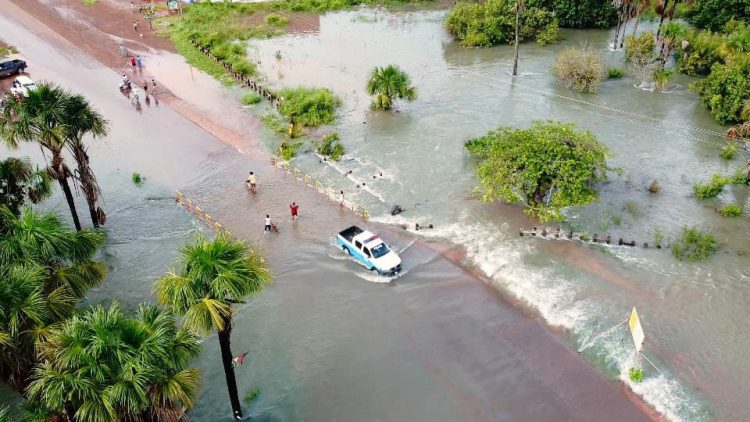A team comprising representatives from regional and international bodies will be conducting the first detailed assessment of the damage caused by the recent flooding in Guyana.
The mission was announced yesterday by the Director General of the Civil Defence Commission (CDC) Lieutenant Colonel Kester Craig during a virtual press conference held to update the country about the flooding across Guyana.
Craig stated that extensive damage assessments are usually very comprehensive and require the skills of experts in the various sectors. With the flooding still ongoing and expected to last for the next couple of weeks, he said, the CDC has to focus on providing relief to persons who have been displaced from their homes and ensure residents are safe. As a result, he said, the agency has asked the Caribbean Disaster Emergency Management Agency (CDEMA) to support a team to conduct the first detailed damage assessment, which will be used as input for more detailed socio-economic impact assessments once the floods have ended.

According to Craig, the regional response team from CDEMA, the Regional Security System (RSS) and the Pan American Health Organisation (PAHO) arrived in Guyana on Thursday, while representative from the Caribbean Public Health Agency (CARPHA) and United Nations Food and Agriculture Organization (FAO), among several other agencies, are expected to arrive on Tuesday.
“With that assessment, we will get an understanding of the damage and losses,” he said before adding that the assessment will commence next week Wednesday. He revealed that there will be five different teams. They are expected to travel to different regions and spend several days gathering data from affected residents, farmers, sugar plantation workers and miners. Craig said that the affected persons will be required to provide pre and current impact information. He noted that the CDC will be providing the team with all the data it has gathered thus far.
In a statement issued yesterday, the CDC noted that the CDEMA team was led by Programme Manager, Joanne Persad, and also included Programme Manager Rasheed Pinder. Also here are RSS Disaster Management and Humanitarian Assistance Officer, Keisha Linton and PAHO Water, Sanitation and Hygiene (WASH) Adviser, Adrianus Vlugman.
Persad was reported as voicing CDEMA’s commitment to assisting Guyana in whatever way possible as the country continues to deal with the national disaster. “We want to make sure our presence here adds value not only to our work but to the next step. That’s critical for us at the end of the day,” she was quoted as saying at a meeting on Thursday with the CDC. .
The CDC said the assessment will include analysis of the sectors to determine the extent of the damage that has occurred, an analysis of the estimated cost to recover, and look at how the recovery estimate can lead to additional support for Guyana in the rebuilding and long term recovery.
“What the report does is it supports the access to financing, it supports projects and programmes, long term recovery and initiatives. It’s the evidence and justification for accessing aid,” Persad stated.
The report will also look at recommendations of what systems could be put in place, if any, to mitigate future such occurrences.
“Generally speaking we work on the principle of building back better, reducing risks and building resilience and reducing vulnerability,” Persad related.
Weeks of torrential downpours have caused rivers and creeks to overflow in several regions across the country, leaving homes, farms, shops and mining pits inundated. According to the CDC, regions Ten, Seven, Six and Five are the most impacted.
Guyana’s flooding has been classified as a Level 2 Disaster under the CDEMA regional response mechanism
Since May 18th, the CDC has received reports that 36,083 households in total have been affected by the flooding countrywide. In Region Six, 12, 391 households are affected while 7,166 have been affected in Region Three; 6,040 in Region Nine; 2,825 in Region One; 2,535 in Region Four; 1,084 in Region Two; 1,791 in Region Ten; 920 in Region Five; 819 in Region Seven and 512 in Region Eight. Some 216 persons are currently being housed at nine temporary shelters that have been activated in regions Two, Five, Nine and Ten.
Craig yesterday stated that CDC continues to receive reports of flooding from all ten administrative regions and the highest priority is assisting those who have been displaced from their homes and those who cannot access food and drinking water. He said ongoing assessments across the regions indicate that livestock and agriculture, transportation and infrastructure, housing and the mining sector have felt the full force of the flooding impact. In Region Eight, he said, random mudslides are occurring as water continues to flow down the mountains. Farmlands are inundated and bridges have been washed away.
In Region Nine, water level has increased in Lethem and farmlands are inundated across the region. He stated that there is a decrease in water levels in Region Ten in some areas but those communities close to the Berbice River remain inundated.
Craig stated that there are demands for a number of items, including cots, boat engines, and aerial transportation. He said that the CDC has been engaging with regional bodies, central government, non-governmental agencies and other partner countries to discuss how the response can be improved. He also stated that they identified the mining areas which are affected and those are located in the Lower, Middle and Upper Mazaruni and some in Region Eight. The first shipment of relief to miners will be delivered early next week.






